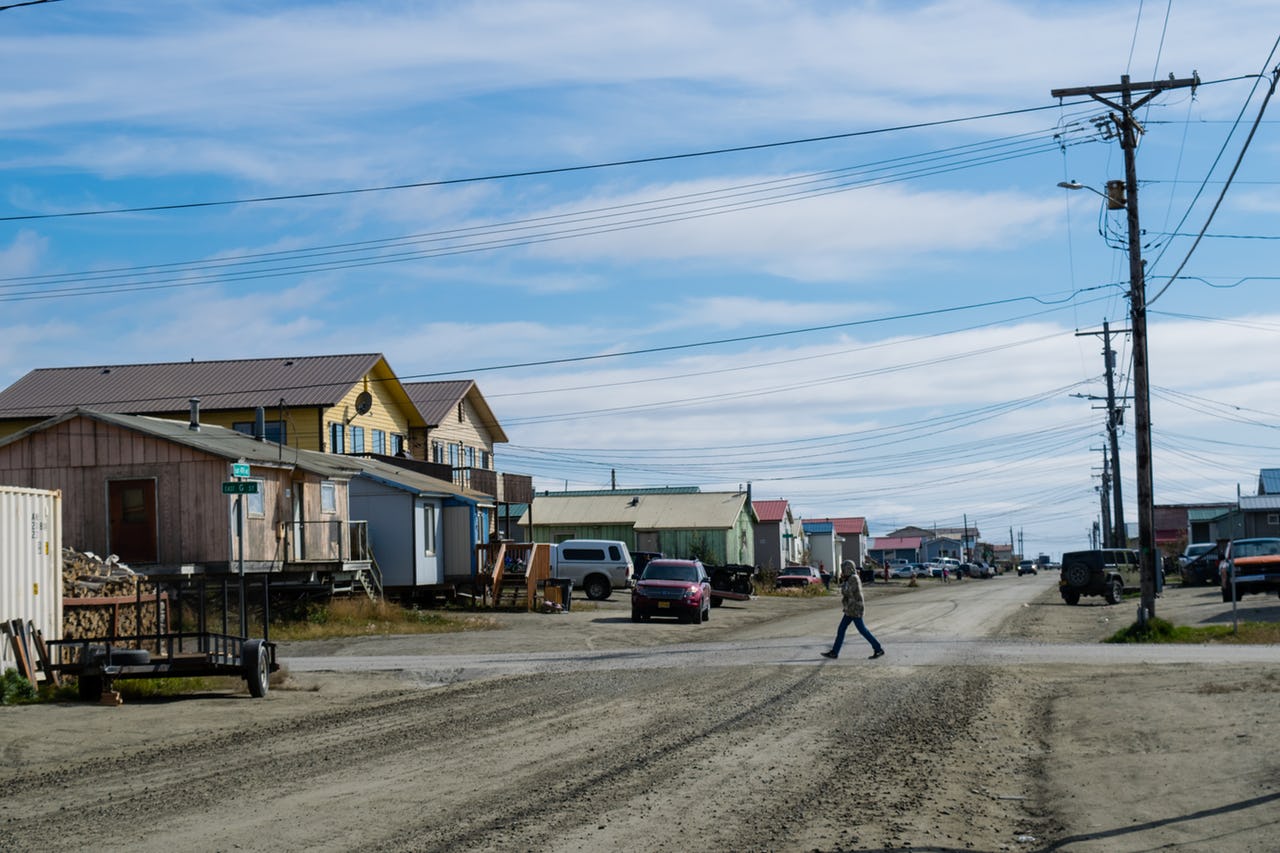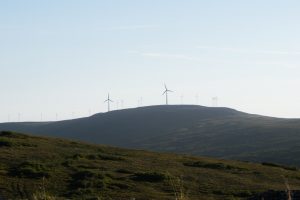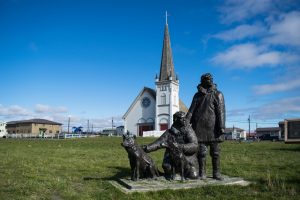A Delicate Balance of Commerce and Climate Change in Nome, Alaska

Nome, Alaska is a small city of some 3,500 people. Photo: Eli Keene
As part of The Arctic Institute’s Summer Reading Series, we are reposting stories from Managing Director Victoria Herrmann’s National Geographic-funded project, America’s Eroding Edges.
The edges of our country are eroding, raising difficult questions about adaptation, relocation, and what it means to be an American experiencing climate change today. To connect the shared experiences of Americans facing these dramatic transformations, the National Trust for Historic Preservation has partnered with Victoria as she travels around the U.S. and its territories interviewing communities directly affected by shoreline erosion and climate change.
The Arctic Institute Summer Readings 2017
- A Continual State of Emergency: Climate Change and Native Lands in Northwest Alaska
- Self-Preservation: Amid Debate, An Alaskan Village Decides to Move Inland
- When the Sea Wall Breaks: Climate Change in Teller, Alaska
- Fighting the Rising Tide in Shaktoolik, Alaska
- Climate Change Hope in America
- A Delicate Balance of Commerce and Climate Change in Nome, Alaska
- Frontier of Change
Nome’s City Hall is a two-story wooden building that looks like it could have been built a century ago during the Alaskan gold rush. Inside, seven city officials are gathered around a conference table to share how the remote settlement of 3,500 people is coping with the consequences of a changing climate. The conversation begins much like other interviews in smaller villages of the region—by discussing variously how the sea ice freezes later and breaks up earlier, and how unpredictable ice conditions have made fishing and crabbing much more dangerous.
“We are absolutely seeing it,” says Tom Moran, the city manager. “Like I said, we can talk about these peripheral kind of things about climate change, but really the bottom line is that our winters are shorter and warmer and our summers aren’t as rainy and are warmer. I’ve only been here five years and there’s been a marked change in the climate. I don’t know if it’s a long-term change or if it was a short-term change. But the winter of 2012 there were 45 straight days of 30-below and this last winter I don’t know we saw two days below zero.”
Nome is—like the rest of the Arctic—experiencing the same dramatic warming trends as nearby villages. But despite the parallel environmental changes, it doesn’t take long for Nome’s climate change experience to depart from that of Northwest Alaska’s small villages. Nome, perhaps more so than any other settlement in Alaska, underlines that climate change is not simply an environmental issue, but a social and economic one as well.
Nome, like the Native villages of Shishmaref and Shaktoolik, is off of Alaska’s road system. It can be reached only by plane (about a ninety-minute flight from Anchorage); by dogsled, most notably as the finish line of the Iditarod race; or by ship.
It is this last transportation option that begins to differentiate Nome from its neighbors. Unlike with nearby villages, the ships that come to Nome are not barges that offload food and fuel supplies once a year during the summer’s open waters. These ships are both larger and more varied—tanker and cargo traffic, gold dredges, commercial fishing vessels, research icebreakers, and cruise ships.
With less ice on the water, Nome is seeing more and bigger ships each year. Just a week before our meeting in September 2016, the Crystal Serenity, an 820-foot cruise ship carrying 1,700 passengers and crew, made a port call in Nome on its way to New York City through the Northwest Passage—the largest cruise ship ever to ply that route.
Joy Baker, the director of Nome’s port, has seen just how dramatic this change in shipping has been.
“It’s no wonder that with receding ice we have increased vessel traffic not only traveling the Bering Strait and through the Northwest Passage and Northeast Passage, but also just arriving sooner and departing later in the Bering Sea operational area,” she says. Joy managed the port by herself for nearly 15 years. But with the increase in ships, her staff is up from 1 to 5. “What that has done is it’s given an opportunity for increased commercial and pleasure traffic, but the domino effect is that it has increased the risk in the area for vessel accidents and maritime incidents—oil spills and life safety issues associated with that growth in mariners in the region.”
This is the climate change story that emerges from Nome’s city officials: a small, remote town trying to strike a delicate balance between capturing the economic opportunity of climate change and mitigating the risks and strains that come with the increased exploitation of a rapidly warming Arctic.

Most of what the city is concerned with understandably focuses around port activity. Joy tells us that in 2007, 184 vessels docked at the Port of Nome, with 12 anchored off shore. In 2015, that went up to 623 ships, with 112 anchored offshore. Having the capacity within the port itself is a challenge, one that the city is hoping to ameliorate with an expansion project. But an increase in traffic from melting sea ice has ripple effects beyond the port, and even beyond Nome. More ships mean more debris, more trash, and more waste streams that affect ocean ecosystems and subsistence hunting of marine mammals.
“There is a tremendous concern about subsistence hunting,” says Richard Beneville, Nome’s animated mayor. “A ship going through the Bering Strait could create a wake that is felt for miles. And a seal hunter might be knocked in. Just in the past five days during the time we were up in Kotzebue, Crystal Serenity, which is now out of Alaskan waters, was notified by one of the villages that whaling was going on and there are whalers out there. And so Serenity was able to move around that, to change their course a bit to allow that. But it’s all having a tremendous impact on subsistence lifestyle, which is 10,000 years old.”
For Austin Ahmasuk, a lifelong Nome resident, Inupiaq hunter, fisher, trapper, and community advocate for Bering Strait villages, a strong wake isn’t the most dangerous thing ships leave behind.
“As we looked at how things like oil spills or hazardous spills are treated in this region, we came to a very dramatic realization—we are the first responders. And we are looking at some 14,000 gallons or so annually of [spilled] oil or hazardous substances in this region,” Austin tells us. Austin has been running community workshops through Kawerak, the nonprofit arm of the Bering Strait Native Corporation, to help communities understand the issues and needs that come with more ships.
“In fact, just today I was in contact with one of our communities in our environmental program about a spill that was occurring in Brevik,” he says, “Just this morning. So it’s some 14,000 gallons annually and the challenge with all those spills is the response. We have very little response capability in this region.”
In this sense, Nome is on the front lines of a choice that will have to be made throughout the Arctic: how can communities embrace much-needed new economic opportunities while safeguarding their environment, land, and way of life? And even more complicated, how does one community embracing this economic opportunity affect other communities that share the same environment?
Further complicating this balancing act is the fact that a warming climate inflicts its own costs on Alaskan communities, costs that further raise the need for new economic opportunity. These costs are clear in Shishmaref, where the village has already voted to relocate entirely; but they are also present in Nome.
John Handeland, Nome’s utilities manager, is quick to point out how difficult it has become just to maintain basic infrastructure as permafrost around the town continues to melt. “There have been areas where we’ve been digging to put in new utilities and as we dig through our corridor, all of the sudden we find these caverns under people’s homes,” he tells us. “They’re sitting on maybe a couple of feet of frozen ground and then they have a 10-foot void underneath there.”
John doesn’t see this getting easier as temperatures continue to rise. “There’s a pretty good picture [from Shishmaref],” he says, “with a house sitting off the edge— that’s happening just because of the erosion right at the ocean—but I foresee pictures similar to that being taken in Nome in the future and right in the middle of town.”
For Nome’s city council, there is some genuine trepidation of how the city will meet the demands of these rapid changes. But there is also genuine excitement about the future here. Midway through the conversation, the mayor has to interject: “This conversation is fascinating because, you know, we all talk about the economic potential for this. But at the same time while we’re out there doing that, we’re also doing the other. Because we too are affected. And it costs a lot of money.”
The commentary was originally published on May 22, 2017.
